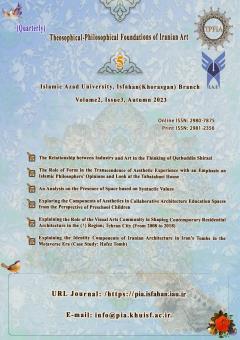Exploring the Components of Aesthetics in Collaborative Architecture Education Spaces from the Perspective of Preschool Children
Subject Areas : Wisdom and architectureAnahita Eskandari 1 , Fahimeh Motazedian 2 * , Ahmad Mirza Kouchak Khoshnevis 3
1 - Ph.D. Student in Architecture, Department of Architecture, Pardis Branch, Islamic Azad University, Pardis, Iran.
2 - Assistant Professor of Architecture, Pardis Branch, Islamic Azad University, Pardis, Iran (Corresponding Author).
3 - Assistant Professor of Tourism, Cultural Heritage and Tourism Research Institute, Tehran, Iran.
Keywords: Architectural Design, Educational Space, P. Taylor, Participation, Preschool Children.,
Abstract :
Creating effective educational environments for children necessitates the utilization of innovative and dynamic spaces that foster their talents and creativity. The design of such spaces is a paramount concern in children's education. Empowering children to articulate their preferences in educational settings can significantly contribute to the architectural design process, resulting in more suitable learning environments. This study explores the architectural elements of collaborative educational spaces from the perspective of preschool children. A total of 212 randomly selected children from across the country participated in the "Anna P. Taylor" educational program, emphasizing a cooperative approach. The study identifies and analyzes essential architectural components required for the development of collaborative educational environments tailored for preschool children, including considerations related to space quality, style, lighting, colors, sounds, and materials. The research employs content analysis, questionnaires, student interviews, crafts, and paintings to scrutinize these components. The findings underscore the significance of color, texture, materials, geometric shapes, volumes, and design approaches in the eyes of children. These factors are categorized as internal and external architectural elements within educational spaces, and the insights gained from this research can guide educational space designers in catering to children's needs. This, in turn, facilitates enhanced learning experiences and the creation of more engaging and efficient spaces for young learners.
دبدبه، محمد. 1400. «طراحی براساس ادراک و رفتارانسانی»، چاپاول، تهران: انتشارات طحانگستر.
دبدبه، محمد. و [دیگران]. 1401الف. «رابطۀ روانشناسی-روانشناختی کودکان در محیط طراحی (مطالعۀموردی: فضاهای آموزشی)»، دومین کنفرانس بینالمللی معماری، عمران، شهرسازی، محیطزیست و افقهای هنراسلامی در بیانیۀ گام دوم انقلاب، تبریز-ایران، 10-1.
دبدبه، محمد. و [دیگران]. 1401ب. «فرایند رهیافتهای ارتقاء آفرینشگری کودکان در محیط طراحی بر تحولات بهعمل آمده در آینده»، دومین کنفرانس بینالمللی معماری، عمران، شهرسازی، محیطزیست و افقهای هنراسلامی در بیانیۀ گام دوم انقلاب، تبریز-ایران، 11-1.
سلطانزاده، حسین 1391. «معماری کودکان»، چاپاول، تهران: انتشارات چهارطاق.
فلاحی، علیرضا. گمینی اصفهانی، هدیه. 1396. «برنامهریزی و طراحی معماری فضاهای دوستدار کودک در فرایند بازسازی پس از زلزلۀ بم»، فصلنامۀ علمیپژوهشی-مسکن و محیط روستا، 36(158): 63-87.
کاملنیا، حامد. 1386. «دستور زبان طراحی محیطهای یادگیری»، چاپدوم، تهران: انتشارات سبحان نور.
هاشمی، نازنین، میرزا کوچک خوشنویس، احمد، محمودی زرندی، مهناز. 1398. «طراحی دبستان باهدف ارتقاء خلاقیت و آموزش معماری به کودکان»، دانشگاه آزاداسلامی، واحد تهرانشمال، 9-1.
Becker, C.R. (2011). ‘From Policies to action, at the international and local levels’. Congress Report of child participation. Italian Committee for UNICEF.
Birch, J., Parnell, R., Patsarika, M., & Šorn, M. (2017). ‘Participating together: dialogic space for children and architects in the design process’. Children's Geographies, 15(2), 224-236.
Eskandari, M., Motazedian, F., & Kouchak Khoshnevis, A. M. (2021). ‘Qualitative Assessment; Design Of Children's Educational Spaces With The Mosaic Approach (Consistent With The Taylor Educational Model)’. Creative City Design, 4(3), 143-155.
Jacobs, S. D. (2018). ‘A history and analysis of the evolution of action and participatory action research’. The Canadian Journal of Action Research, 19(3), 34-52.
Laaksonen, Esa ., Räsänen, Jaana. (2006). ‘PLAYCE: Architecture Education For Children & Young People.Alvar Aalto Academy’, Helsinki.
Lesteven, G. (Ed.). (2023). ‘Urban Mobility Systems in the World’. John Wiley & Sons.
Matthews, E., & Lippman, P. C. (2020). ‘The design and evaluation of the physical environment of young children’s learning settings’. Early Childhood Education Journal, 48, 171-180.
McDonnell, J. )2012(. ‘Accommodating Disagreement: A Study of Effective Design Collaboration’, Design Studies 33: 44–63.
Meetoo, V., Cameron, C., Clark, A., & Jackson, S. (2020). ‘Complex ‘everyday’lives meet multiple networks: the social and educational lives of young children in foster care and their foster carers’, Adoption & Fostering, 44(1), 37-55.
Milo, A. (2020). ‘The acoustic designer: Joining soundscape and architectural acoustics in architectural design education’, Building Acoustics, 27(2), 83-112.
Ó Longaigh, B., Noonan, J., Trubetskaya, A., & McDermott, O. (2023). ‘Strategic facility & space planning utilizing Design for Lean Six Sigma’, International Journal of Sustainable Engineering, 16(1), 1-13.
Parnell, R., and M. Patsarika. (2020). ‘Evaluating the Sorrell Foundation Joinedupdesign for BSF’, The University of Sheffield School of Architecture.24-28, 211-224.
Tayefi Nasrabadi, M., García, E. H., & Pourzakarya, M. (2021). ‘Let children plan neighborhoods for a sustainable future: a sustainable child-friendly city approach’, Local Environment, 26(2), 198-215.
Wegerif, R. )2008(. ‘Dialogic or Dialectic? The Significance of Ontological Assumptions in Research in Educational’, British Educational Research Journal, Volume 34, 2008 - Issue 3:347-361.
Wright, N., Thompson, T., & Horne, T. (2021). ‘Talking spaces: Architects and educators’, New Zealand Journal of Educational Studies, 56(Suppl 1), 45-59.
_||_
